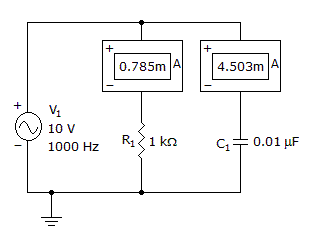Electronics - Capacitors - Discussion
Discussion Forum : Capacitors - General Questions (Q.No. 14)
14.
What is the circuit's total current?


Discussion:
9 comments Page 1 of 1.
JJC said:
8 years ago
Ir and Ic are not in phase (90 degrees out of phase).
In a graphical analysis, they will form a right triangle, the longest side (hypotenuse) is the total current (geometric sum), which can be solved by using the Pythagorean theorem. It=sqrt(Ir^2 + Ic^2).
In a graphical analysis, they will form a right triangle, the longest side (hypotenuse) is the total current (geometric sum), which can be solved by using the Pythagorean theorem. It=sqrt(Ir^2 + Ic^2).
Ashutosh said:
1 decade ago
Current across the capctor leads the current across the resistor by 90 in phase diagram.
so,total current=sqrt(sq(Icapactor)+sq(Iresistor)).
so,total current=sqrt(sq(Icapactor)+sq(Iresistor)).
(1)
Devadas said:
1 decade ago
I=0+Ir+(11+(-11)+(0+Ic))
where 11 is a number
You can take any number in that place.
where 11 is a number
You can take any number in that place.
Vasu said:
1 decade ago
I= sq root (Ir^2+Ic^2)
so I= sq root (0.785^2 + 4.508^2)
=4.57mA
so I= sq root (0.785^2 + 4.508^2)
=4.57mA
Ravi said:
1 decade ago
We know that V=IZ where z=R//X where X=1/2PIfc.
Anee said:
1 decade ago
Current in parallel form added.
Hirak said:
8 years ago
Why square rooting Ir & Ic?
Rishitha chittoory said:
10 years ago
Why square rooting the value?
Zohra said:
1 decade ago
Not clear.
Post your comments here:
Quick links
Quantitative Aptitude
Verbal (English)
Reasoning
Programming
Interview
Placement Papers